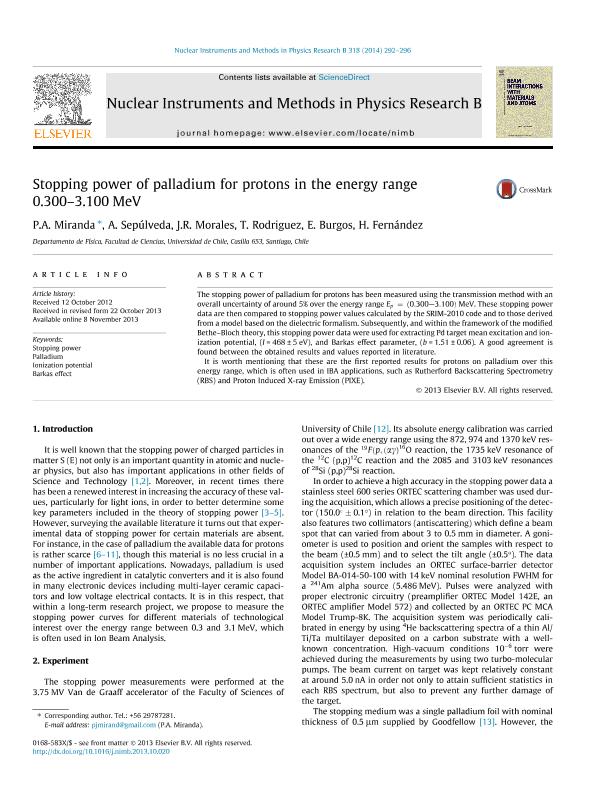Mostrar el registro sencillo del ítem
dc.contributor.author
Miranda, P. A.
dc.contributor.author
Sepúlveda, A.
dc.contributor.author
Morales, J.R.
dc.contributor.author
Rodriguez Cabello, Tabatha Pamela

dc.contributor.author
Burgos, E.
dc.contributor.author
Fernandez, H.
dc.date.available
2017-12-28T18:18:52Z
dc.date.issued
2014-01
dc.identifier.citation
Fernandez, H.; Burgos, E.; Rodriguez Cabello, Tabatha Pamela; Morales, J.R.; Sepúlveda, A.; Miranda, P. A.; et al.; Stopping power of palladium for protons in the energy range 0.300–3.100 MeV; Elsevier Science; Nuclear Instruments and Methods in Physics Research B: Beam Interactions with Materials and Atoms; 318B; 1-2014; 292-296
dc.identifier.issn
0168-583X
dc.identifier.uri
http://hdl.handle.net/11336/31846
dc.description.abstract
The stopping power of palladium for protons has been measured using the transmission method with an overall uncertainty of around 5% over the energy range Ep=(0.300–3.100) MeV. These stopping power data are then compared to stopping power values calculated by the SRIM-2010 code and to those derived from a model based on the dielectric formalism. Subsequently, and within the framework of the modified Bethe–Bloch theory, this stopping power data were used for extracting Pd target mean excitation and ionization potential, (I = 468 ± 5 eV), and Barkas effect parameter, (b = 1.51 ± 0.06). A good agreement is found between the obtained results and values reported in literature. It is worth mentioning that these are the first reported results for protons on palladium over this energy range, which is often used in IBA applications, such as Rutherford Backscattering Spectrometry (RBS) and Proton Induced X-ray Emission (PIXE).
dc.format
application/pdf
dc.language.iso
eng
dc.publisher
Elsevier Science

dc.rights
info:eu-repo/semantics/openAccess
dc.rights.uri
https://creativecommons.org/licenses/by-nc-sa/2.5/ar/
dc.subject
Stopping Power
dc.subject
Palladium
dc.subject
Ionization Potential
dc.subject
Barkas Effect
dc.subject.classification
Astronomía

dc.subject.classification
Ciencias Físicas

dc.subject.classification
CIENCIAS NATURALES Y EXACTAS

dc.title
Stopping power of palladium for protons in the energy range 0.300–3.100 MeV
dc.type
info:eu-repo/semantics/article
dc.type
info:ar-repo/semantics/artículo
dc.type
info:eu-repo/semantics/publishedVersion
dc.date.updated
2017-12-26T20:39:53Z
dc.journal.volume
318B
dc.journal.pagination
292-296
dc.journal.pais
Países Bajos

dc.journal.ciudad
Amsterdam
dc.description.fil
Fil: Miranda, P. A.. Universidad de Chile; Chile
dc.description.fil
Fil: Sepúlveda, A.. Universidad de Chile; Chile
dc.description.fil
Fil: Morales, J.R.. Universidad de Chile; Chile
dc.description.fil
Fil: Rodriguez Cabello, Tabatha Pamela. Universidad de Chile; Chile. Consejo Nacional de Investigaciones Científicas y Técnicas; Argentina
dc.description.fil
Fil: Burgos, E.. Universidad de Chile; Chile
dc.description.fil
Fil: Fernandez, H.. Universidad de Chile; Chile
dc.journal.title
Nuclear Instruments and Methods in Physics Research B: Beam Interactions with Materials and Atoms

dc.relation.alternativeid
info:eu-repo/semantics/altIdentifier/doi/http://dx.doi.org/10.1016/j.nimb.2013.10.020
dc.relation.alternativeid
info:eu-repo/semantics/altIdentifier/url/http://www.sciencedirect.com/science/article/pii/S0168583X13010458
Archivos asociados
